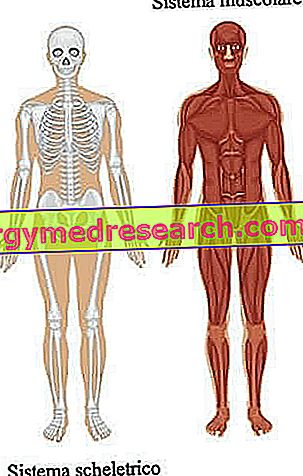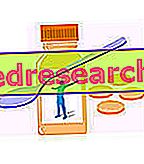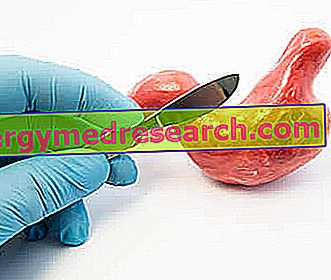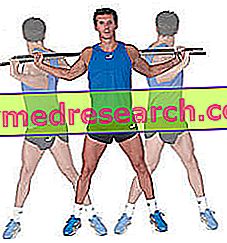Generality
The locomotor apparatus is the result of the union between the skeletal apparatus and the muscular apparatus.
The main anatomical elements that constitute it are: bones, cartilaginous tissue, muscles, joints, tendons and ligaments.

- The bones form the skeleton and serve to give stability and support to the human body, and to protect some internal organs;
- cartilage tissue supports bone action;
- skeletal muscles serve movement;
- the muscles of the heart serve to contract the latter;
- the smooth muscles line the hollow organs present in the body;
- joints, tendons and ligaments allow bones and muscles to function at their best and allow correct skeleton movements.
Among the most important diseases of the musculoskeletal system, include: arthritis, bone fractures, muscle injuries, tendonitis and joint sprains.
What is the locomotor apparatus?
The musculoskeletal system, or musculoskeletal system, is the complex of bones, muscles and attached structures that guarantees stability, support and movement capacity to the human being.
The locomotor apparatus is, therefore, the result of the union between the skeletal system (or skeletal system ) and the muscular apparatus (or muscular system ).
Organization
The musculoskeletal system includes the bones of the skeleton, the cartilaginous tissue, the muscles, the tendons, the joints, the ligaments and all those connective tissues that join together the various anatomical structures (including other tissues and other organs) present in the Human Body.
SKELETON AND BONE
The human skeleton is the structured set of the various bones that reside within the body.
At birth, the skeleton of the human being comprises more than 300 bones; during the growth process, several bones fuse together and this means that, in adulthood, the total number of bone elements present in the human body is 206 .
It should be noted that the number of human bones is the subject of numerous debates, as some anatomists consider certain bone elements, considered a unique piece by most, as the set of two distinct bones.
The bones of the human body differ in shape and size. Based on the above parameters, it is possible to recognize the existence of at least 5 types (or classes) of bones:
- Long bones . Bone elements are thus called in which the length prevails over thickness and width. They comprise three regions: a central region, called the diaphysis, and two lateral regions (at the ends of the diaphysis) called proximal epiphysis (the end closest to the center of the body) and distal epiphysis (the end furthest from the body).
In the diaphysis of long bones lies the bone marrow, the organ responsible for the synthesis of blood cells (red blood cells, white blood cells and platelets).
Examples of long bones: femur, tibia, fibula (or fibula), humerus, radius, ulna etc.
- Short or short bones . They are bones whose length and diameter are very similar.
The spongy fabric which constitutes it presents a laminar covering of fabric with a very compact appearance.
Examples of short or short bones: wrist bones, calcaneus bones, vertebral bones, etc.
- Flat bones . They are the bones in which width and length prevail over the thickness.
They resemble short bones: they have a spongy texture in the center, with a laminar coating of compact fabric.
Examples of flat bones: skull bones, pelvic bones, sternum bones, etc.
- Irregular bones . They are irregularly shaped bones.
Examples of irregular bones: sphenoid bone and ethmoid bone of the skull.
- Sesamoid bones . They are bones that look similar to sesame seeds. Their function is to favor the mechanics of movement.
Examples of sesamoid bones: patella and pisiform bone of the carpus of the hand.
The skeleton covers several important functions:
- It gives shape to the body.
- It guarantees support and protection for some internal organs.
- Allows body movements.
- It produces blood cells, through the bone marrow.
- It serves as a storage point for minerals taken with the diet and essential for the good health of the entire body.
CARTILAGINEO FABRIC
Cartilaginous tissue (or cartilage ) is a connective tissue that has a supporting function and is extremely flexible and resistant.
Cartilage consists of particular cells - the so-called chondrocytes - and is devoid of blood vessels.
In the human body, the cartilaginous tissue present may have different peculiarities, depending on the functions it has to perform. In this regard, consider for example the cartilage of the auricles and cartilage of the menisci of the knee: although belonging to the same category of tissue, and despite being composed of chondrocytes, these two cartilaginous tissues differ considerably in consistency and specific properties.
| Types of cartilage in the human body | Where to find it? Some examples |
Hyaline cartilage | Ribs, nose, trachea and larynx |
Elastic cartilage | Auricle, Eustachian tube and epiglottis |
Fibrous cartilage | Intervertebral discs, menisci and pubic symphysis |
MUSCLES
Muscles are the organs responsible for the movement of the body and some of its parts.
In fact, they confer motility to the skeleton, to some sense organs (for example the eyes) and to small anatomical structures (for example the hairs of the skin).
The locomotor apparatus, to be precise its muscular component, includes two different types of muscles:
- Striated muscles and
- Smooth muscles
The skeletal musculature and the cardiac musculature (or myocardium ) belong to the typology of the striated muscles.
The skeletal musculature includes all the muscular elements that, through their union with the bones of the skeleton, allow the movement of the body.
The cardiac musculature, on the other hand, is the muscular component that characterizes the contractile walls (atria and ventricles) of the heart.
While skeletal musculature is voluntary (that is, it is the human being, through nerve impulses, that controls its contraction and relaxation), the cardiac musculature is involuntary and possesses the extraordinary ability to self-control.
Moving on to the smooth muscles, these are the muscular elements characteristic of the internal hollow organs - such as the stomach, intestine, bladder, uterus, blood vessels and lymphatic vessels - and some particular anatomical structures - including the inner part of the eyeball (dilating muscles of the pupil) and the cutaneous hairs (erector muscles of the hairs).
Smooth muscles are involuntary .
Sometimes, in some human anatomy books, the muscles are divided into three types instead of two: the skeletal musculature, the cardiac musculature and the smooth musculature.
TENDONS
A tendon is a formation of fibrous connective tissue, with a certain flexibility, which unites a skeleton muscle with a bone element.
Thus, the previously described skeletal muscles find insertion on the skeleton, by means of the tendons.
The anatomical texts and experts have the tendency to identify the initial extremity and the terminal extremity of a muscle with the tendon present on each of these two extremities.
The function of tendons is to transform the force generated by the contraction of skeletal muscles into movement.
How many are the tendons of the human body?
Anatomists have calculated that there are 267 tendons in the human body.
JOINTS
The joints are anatomical structures, sometimes complex, which put two or more bones in mutual contact.
In the human body, there are about 360 of them and their task is to keep the various bone segments together, so that the skeleton can fulfill its function of support, mobility and protection.
The anatomists divide the joints into three main categories:
- Fibrous joints (or synarthrosis ), lacking in mobility and whose bones are joined by fibrous tissue. Examples are the bones of the skull.
- Cartilaginous joints (or amphiarthrosis ), with poor mobility and whose bones are linked by cartilage. Classic examples of amphiartrosis are vertebral vertebrae.
- The synovial joints (or diarthrosis ), which thanks to their particular conformation are extremely mobile. Elements such as the articular surfaces (ie the bones involved in diarthrosis), the joint capsule, the articular cavity, the layer of hyaline cartilage that covers the articular surfaces, the synovial membrane (or synovium), the synovial bags contribute to this particular conformation., ligaments and tendons. The most well-known diarthrosis is the knee, shoulder or ankle joints.
What are synovial bags?
A synovial bursa is a liquid-filled pouch wrapped in a synovial membrane.
The presence of synovial bags, at the level of diarthrosis, aims to reduce the friction between the bone components involved.
LIGAMENTS
Ligaments are fibrous connective tissue formations that join together two distinct bones or two different parts of the same bone.
They are fundamental components of the joints: the controlled and physiological movement of the joint elements depends on them.
Without the ligaments or if its ligaments have a lesion, a joint works badly and is unstable; furthermore, its constituent parts are susceptible to breakage or abnormal behavior.
Function
The primary functions of the locomotor apparatus are three:
- Offer support and support to the human body
- Allow locomotion and all the various types of body movements
- Protect vital internal organs
diseases
Different pathologies and problems can affect the musculoskeletal system.
The most important and widespread in the general population are, without a doubt:
- The various forms of arthritis . Arthritis is the medical term that indicates the presence of inflammation on one or more joints.
There are different types (or forms) of arthritis, each with unique causes and characteristics.
The types of arthritis that deserve a special mention are: osteoarthritis (arthrosis), rheumatoid arthritis, ankylosing spondylitis, cervical spondylosis, systemic lupus erythematosus, gout, fibromyalgia, reactive arthritis (or syndrome of Reiter) and psoriatic arthritis.
- Bone fractures . As can be easily understood, a bone fracture is the breaking of a bone.
The most common causes of bone fractures are impact trauma (car accidents, falls, sports injuries, etc.).
A very important risk factor for bone fractures is osteoporosis. Osteoporosis is a systemic disease of the skeleton, which causes a strong weakening of the bones. This weakening results from the reduction of bone mass, which, in turn, is a consequence of the deterioration of the microarchitecture of the bone tissue.
- Contractures, strains and muscle sprains . They are specific problems of the muscular apparatus of increasing gravity.
A muscle contraction is an involuntary, insistent and painful contraction of one or more skeletal muscles. A contracted muscle is a rigid muscle, whose fibers exhibit appreciable hypertonia to the touch.
A muscle strain is a medium-sized lesion that alters normal muscle tone. It is a problem that, by gravity, is interposed between the contraction and the tearing of a skeletal muscle.
Finally, a muscle tear is a fairly serious injury that involves the breaking of a not inconsiderable number of fibers making up a given muscle. By gravity, muscle tears precede both contractures and muscle strains.
- The various forms of tendinitis . Tendonitis is the medical term for inflammation of a tendon.
Among the possible causes of tendinitis, the most common is the chronic repetition of microsupportings, which go to alter the normal anatomy of the affected tendon structure.
The tendons most commonly subject to tendonitis are: the patellar tendon of the knee, the tendons of the elbow and the tendons of the shoulder (to be precise, the tendons of the so-called rotator cuff).
- Articular distortions, with more or less serious involvement of the ligaments. Articular distortions are the result of traumas or unnatural movements of the joints, movements that produce more or less severe damage to the ligaments.
This damage to the ligaments is a reason for a certain articular instability: due to joint instability, it is understood that the affected joint works in an anomalous manner and no longer allows the execution of certain body movements.
The joints most prone to distortion are: the knee, the ankle, the wrist and the elbow.
Joint sprains are diseases of the musculoskeletal system which are prevalent especially among sportsmen.



